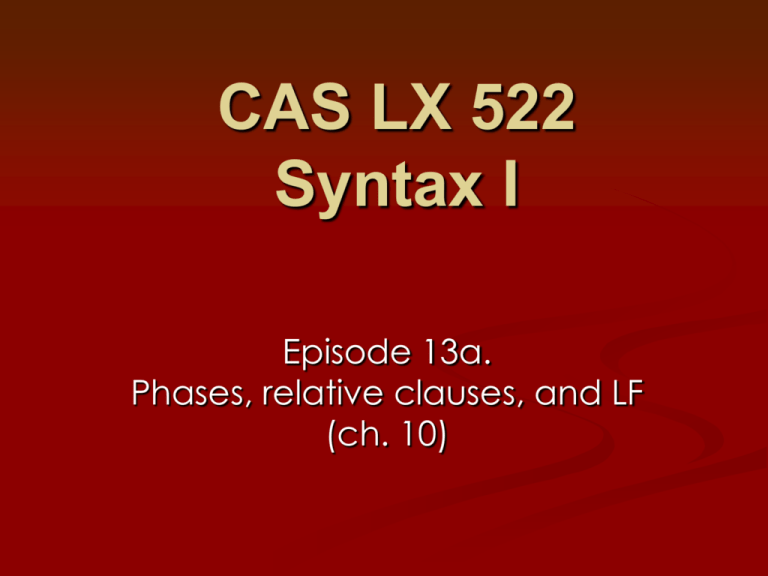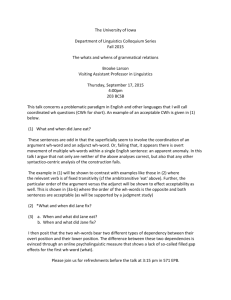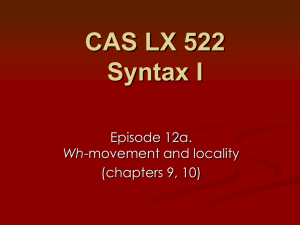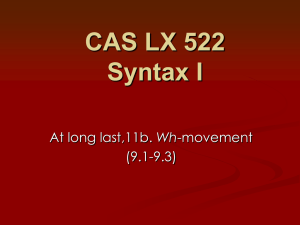PowerPoint
advertisement

CAS LX 522 Syntax I Episode 13a. Phases, relative clauses, and LF (ch. 10) Reminder: wh-questions In wh-questions such as What did they bake? Questions are differentiated from declaratives in having a “question complementizer”: C [uwh*, clause-type:Q] What is like a pronoun, standing in for the theme. Wh-words are differentiated by having a [wh] feature. The structure of a wh-question is like a V2 clause: T moves to C—except in subject wh-questions: The [uclause-type:] feature of T is strong when valued as Q. The [uclause-type:] feature of T can be valued by [wh] from above. The closest (to C; topmost) wh-word moves to SpecCP: The interrogative C has a strong uninterpretable [uwh*] feature. “Superiority”: Shorter moves are better, take the closest wh-word. What will they bake? What moves to SpecCP and checks the [uwh*] feature of C. DP CP C what [wh] C [Q, uwh*] DP they T moves to check the (now strong) [uclausetype:Q*] feature. (Not pictured here) TP T T MP M vP <M> will T <DP> v [uclause-type:] v V bake v VP <V> <DP> Who signed the press release? CP DP who [wh] In subject whquestions, T does not move to C. Now the head of T’s sister is v, so tense is pronounced on the verb. C C [Q, uwh*] TP T <DP> T [past, [uclause-type:wh] vP <DP> v V sign v VP v <V> DP [uInfl:past] the press release Will they bake pie? Op appears in yes-no questions in the same place that wh-words do in whquestions (and we assume it has a [wh] feature as well). Op is probably like a “silent” whether (wh+either). CP DP C Op TP [wh] C [Q, uwh*] DP they T T vP will [uclause-type:] <DP> v v V bake VP v <V> DP pie Scottish Gaelic tells us whwords stop in intermediate SpecCPs Bha mi ag ràdh gun do bhuail i e. was I ASP saying that PRT struck she him ‘I was saying that she hit him.’ Tha mi a’ smaoineachadh gu bheil Iain air a mhisg. am I ASP thinking that is Iain on his drink ‘I think that Iain is drunk.’ Cò bha thu ag ràdh a bhuail i? who were you ASP saying that struck she ‘Who were you saying that she hit?’ Cò tha thu a’ smaoineachadh a tha air a mhisg? who are you ASP thinking that is on his drink ‘Who do you think is drunk?’ “Unbounded” movement is really a bunch of relatively short movements. Where it looked like wh-words were moving over great distances, those distances were traversed in small steps. What did Kate think [CP <what> Claire said [CP <what> Charlie heard [CP <what> Jack brought <what> ]]]? If wh-movement is in fact constrained not to move “too far”, this explains how it can look like whmovement is unbounded. What it means to “move too far” Two questions: Why can a wh-word stop in an intermediate SpecCP? [CP What did Abe say [CP <what> that Bart stole <what>]]? Why must a wh-word stop in an intermediate SpecCP? *[CP What did Abe say [CP that Bart stole <what>]]? Phases Sentences are built up in “chunks”, called phases. A CP constitutes a phase. You build (collecting items from the workbench, Merging, Moving) until you’ve built a phase. Then, you “commit” it—after which, you can’t “see into it” further than the specifier. [CP C[uwh*] [TP Abe T say [CP that [TP Bart stole what… [CP C[uwh*] [TP Abe T say [CP what that [TP Bart stole <what>… If [uwh*] is ever going to be checked, what must be visible to it. It must get to SpecCP before it’s too late (before the CP is finished and “committed”). Optional [u wh*] To allow what to move to an embedded SpecCP, we need to be able to add (optionally) a [uwh*] feature even to a C that is not itself [clause-type:Q]. [CP C[uwh*] [TP Abe T say [CP what that [TP Bart stole <what>… If you don’t, the topmost [uwh*] can never be checked. Embedded C may optionally bear [uwh*]. Phases explain islands: Whislands It’s not possible to turn the following sentence into a question asking about the kidnappee— Pat asked [CP who kidnapped the Lindbergh baby]. *Who did Pat ask [CP who kidnapped <who>]? Because the lower who can’t move up to the intermediate SpecCP—It gets frozen inside the phase. But—what’s wrong with this? *Who did Pat ask [CP <who> kidnapped who ]? CNP islands—DP is a phase We can use the same kind of explanation for the Complex Noun Phrase islands: *Who does Jack believe [DP the claim [CP that the list does not include _ ]]? If we suppose that DP, like CP, is a phase. *Who does Jack believe [DP the claim [CP that the list does not include _ ]]? Adjunct islands One last type of island we’ll consider is the adjunct island. Generally: A wh-word cannot escape an adjoined modifier. Dr. Hibbert laughed [CP when Homer lost a finger]. *What did Dr. Hibbert laugh [CP when Homer lost]? We don’t yet have a good explanation for this. So far, we predict these should be possible. Adjunct islands To account for the islandhood of adjuncts in our system, we will add one further condition: The specifier of a phase is only visible to feature matching if the phase gets a q-role. Note: Adger makes this one step more complicated, to account for “subject islands” but we won’t do that here. Adjuncts differ from arguments in precisely this property. Islands and phases, summary… Sentences are “chunked” into phases as they are built up. Phases are CP and DP. A feature outside of a phase cannot match a feature further inside the phase than its specifier. This leads to island phenomena, configurations in which a wh-word would be “trapped”: CNP islands: A wh-word cannot get to the specifier of DP and so is not visible from outside. Wh-islands: A wh-word cannot get to the specifier of an embedded question (that already has a wh-word, or Op, in its specifier). Adjunct islands: Even the specifier is not visible if the phase did not get a q-role. “Island effects” are a property of movement. Consider the following: Jack believes [DP the claim [CP that the list does not include Ethan ]]? *Who does Jack believe [DP the claim [CP that the list does not include _ ]]? Who believes [DP the claim [CP that the list does not include who ]]? Dr. Hibbert laughed [CP when Homer lost a finger ]. *What did Dr. Hibbert laugh [CP when Homer lost _ ]? Who laughed [CP when Homer lost what ]? So long as the wh-phrase doesn’t move, it seems that there’s no problem with simply having a wh-phrase inside an island. “Island effects” are a property of movement Japanese: a wh-in-situ language. Taroo-ga [DP Hanako-ni nani-o ageta hito-ni ] aimasita ka? T-nom H-dat what-acc gave man-dat met.pol Q ‘*What did Taro meet [ the man that gave _ to Hanako ]?’ Taroo-ga [CP Hanako-ga nani-o yomu maeni ] dekakemasita ka? T-nom H-nom what-acc read before left.pol Q ‘*What did Taro leave [ before Hanako read _ ]?’ Wh-words don’t move. Islands don’t matter. Why phases? One of the main motivations behind phases (conceptually—empirically, there is plenty of evidence) is that is makes computation easier. What happens when a phase is “committed”? That is, again, the system is lazy. It works in chunks, it never has to look too far to find a feature for checking. The standard idea is that the phonological interpretation and semantic interpretation of that chunk becomes fixed, and can’t be altered later. Terminology: “Spell-out” Terminology: The requirement that movement not go “too far” (not escape a committed phase) was known in the old days as Subjacency—you may still encounter this term when talking to linguists at parties (or reading older papers). Relative clauses Another place where we see whmovement, besides in explicit questions (either in the main clause or embedded) is in relative clauses. The book which I read The woman who(m) I met These consist of a head noun (book, woman) and then what appears to be a wh-question that further specifies the referent of the head noun. Relative clauses Relative clauses serve to modify the head noun. Kind of like adjectives, or PP modifiers. The unhappy students. The students from Vancouver. The students who solved the problem. So where would you put them? Relative clauses The structure of a relative clause: A CP [clause-type:Rel, uwh*] is adjoined to the NP, like an adjective, or a PP modifier. The meaning is essentially “the man with the property of being the answer to ‘Who did I meet?’ ” We’ll see in a moment that C [Rel] can be pronounced as either Ø or as that. DP D the nP man nP CP DPi who(m) C C TP [uwh*] [c-t:Rel] I met t i Differences between questions and relative clauses The “question” inside a relative clause has a couple of odd properties, not shared with regular main clause or embedded questions. *The problem what I solved. The problem which I solved. The problem which I will solve. The problem I solved. The problem that I solved. Which/that/Ø In addition to being able to say The book which Mary read We can also say The book that Mary read and The book Mary read And they all mean the same thing. So we expect that they would all have basically the same structure (they all have a question adjoined in the nP)—so where is the wh-word in the last two? Op The secret to these last two kinds of relative clauses is Op, the silent wh-word. That is, the book which Mary read and the book Mary read are really exactly the same except that in one case you pronounce the wh-word, and in the other, you don’t. the book [CP whichi Mary read ti ] the book [CP Opi Mary read ti ] Op It is also possible to pronounce that with Op, giving us: the book [CP Opi that [TP Mary read ti ]] Why can’t we pronounce that with which? *the book [CP whichi that [TP Mary read ti ]] Doubly-Filled COMP filter The Doubly-Filled COMP filter is the traditional “explanation”: Doubly-Filled COMP filter: *[CP wh-word if/that/for…] You can’t pronounce both a wh-word and C at the same time. Thus: the book [CP Opi [TP Mary read ti ]] the book [CP Opi that [TP Mary read ti ]] the book [CP whichi [TP Mary read ti ]] *the book [CP whichi that [TP Mary read ti ]] Op Skeptical of Op? Is there really wh-movement of Op, a silent wh-phrase? I read the book [CP whichi [TP Mary said [CP that [TP Bill bought ti ]]]]. *I read the book [CP whichi [IP Mary wonders [CP who [TP bought ti ]]]]. I read the book [CP Opi (that) [TP Mary said [CP that [TP Bill bought ti ]]]]. *I read the book [CP Opi (that) [TP Mary wonders [CP who [TP bought ti ]]]]. Op So if we have a silent wh-phrase, why can’t we ask questions with it? Wherei did Mary buy this book ti ? Wheni did Mary buy this book ti ? The reason [Opi Mary bought this book ti ] Howi did Mary buy this book ti ? The time [Opi Mary bought this book ti ] Whyi did Mary buy this book ti ? The place [Opi Mary bought this book ti ] The way [Opi Mary bought this book ti ] *Opi did Mary buy this book ti ? See why? Op Recoverability condition: The content of a null category must be recoverable. the place [Opi (that) Mary bought that book ti ] the day [Opi (that) Mary bought that book ti ] the reason [Opi (that) Mary bought that book ti ] the way [Opi (that) Mary bought that book ti ] In each case, we can tell what the whphrase is by looking at the head noun. A word about interpretation Let’s think for a moment about what a wh-question means: Who did Pat meet? [CP [DP who]i Tk+C [TP Pat meet tk]] Something like (a ‘logical form’): Tell me (a person) x such that Pat met x is true. Pronouncing & interpreting There are two things we need to do with the lexical items we assemble on the workbench: Pronounce the sentence Interpret the sentence We’ve mainly been concentrating on the pronunciation part (getting the words into the order we hear them), but the structure is also assumed to be the basis for interpreting the sentence as well. Our model of grammar Here is the little picture of our model of grammar. The structure we end up with is used both to express the logical relations between participants and to pronounce the structure. (And of course it has to be that way, since how a sentence sounds is tied to what it means). pronounce Lexicon Merge, Adjoin, Copy/Move Workbench interpret A word about interpretation Who did Pat meet? [CP [DP who]i Tk+C [TP Pat meet tk]] Tell me (a person) x such that is Pat met x is true. If we need to get to a logical structure like Tell me (a person) x such that Pat met x is true, then it may well be that this is what wh-movement is for. The trace serves as the x variable, the moved wh-phrase sets the domain. Suppose that moving a wh-phrase (leaving a trace) is necessary for interpretation as a wh-question. Wh-movement and interpretation Who bought what? Tell me a (person) x and tell me a (thing) y such that x bought y is true. Who gave what to whom? Tell me a (person) x and tell me a (thing) y and tell me a (person) z such that x gave y to z is true. How do we interpret those other wh-words? The wh-typology English: One wh-word moves to the front. Japanese: No wh-words move to the front. Taroo-ga dare-ni nani-o ageta no? T-nom who-to what-acc gave Q ‘What did Taroo give to whom?’ Bulgarian: All wh-words move to the front. What did Bill give to whom? Kakvo na kogo Ivan dade? what to whom Ivan gave ‘What did Ivan give to whom?’ French: One wh-word or no wh-words move to the front. Qui as-tu vu? Who have-you seen ‘Who did you see?’ Tu as vu qui? You have seen who ‘Who did you see?’ The wh-typology Yet in all of these languages, the meaning of What did Bill give to whom? is the same… Tell me a (thing) x and tell me a (person) y such that Bill gave x to y. So, if the ‘tell me an x…such that…x…’ meaning arises from wh-movement (and, in fact, we can see the wh-movement in Bulgarian), it stands to reason that even in English and Japanese there is wh-movement for each wh-word—we just can’t always hear it. ¿Qué? Wh-movement… that you can’t hear… The next topic (quantifiers) will give us pretty good evidence that there is such a thing as “movement you can’t hear.” Adopting it here allows for a uniform view of meaning and structure across languages, even in the face of the (superficial) differences in wh-movement behavior. So, let’s provisionally accept it and see where it leads. Phases again Remember that what’s supposed to be true of phases is when they are “committed,” we have locked in the pronunciation and interpretation. But what if we lock in the pronunciation first, move a little bit more, and then lock in the interpretation? [CP whati Tk+C [TP Pat tk give ti to whom ]]? [CP whomm whati Tk+C [TP Pat tk give ti to tm ]]? Lock in pronunciation Lock in interpretation This will sound like: What did Pat give to whom? Phases again Why would we lock in pronunciation first? [CP whati Tk+C [TP Pat tk give ti to whom ]]? [CP whomm whati Tk+C [TP Pat tk give ti to tm ]]? Lock in pronunciation Lock in interpretation We said before: Strong features (generally) require movement because the strong feature must be local to the feature that checks it. Viewed in light of different “timing” for locking in pronunciation and interpretation, we could now say that strong features need to be checked before locking in pronunciation. But since the system is lazy, it will wait until after that to check any remaining (weak) features. Benefits and problems If we imagine that there can be this type of “covert movement” we gain a strong benefit: All languages have basically the same structure for the purposes of interpretation. Even if they seem to differ in terms of what visibly moves. But it raises a number of issues as well: We must assume that once you covertly move something, you’ve left the phonological features behind—any further movement will also have to be covert. We must assume that all wh-words accumulate in SpecCP (some covertly) but without losing the explanation of whisland violations (there is only one SpecCP). Covert movement seems not to obey islands: Strong features can’t see inside committed phases, but others seem to be able to. Non-strong features won’t affect the pronunciation, though—it’s ok when the pronunciation is locked. LF movement When syntacticians talk about this kind of “covert movement” at parties, they sometimes speak of it as LF movement. That is, movement that happens in order to construct the logical form of the sentence but doesn’t affect the pronunciation. We will not really seriously deal with LF movement in this class. We will not draw it in our trees. But it’s worth having heard about it. Wh-phrases binding pronouns There is an interesting property of the kind of operator-variable formation that we can see in wh-movement. Who likes his roommate? Pick the x such that x likes x’s roommate. Whoi [TP ti likes hisi roommate] Notice that it is possible to have a pronoun bound by a wh-word. And it is binding, like the binding we spoke of wrt Binding Theory. It’s assignment of reference, both to the trace and to his, matching the reference of who. Weak Crossover But now consider this: Who does his roommate like? Can this mean the same thing as Whose roommate likes him? *Whoi does hisi roommate like ti ? How is this different from Whoi ti likes hisi roommate? [Whose roommate]i ti likes himi ? WCO *Whoi does hisi roommate like ti ? Whoi ti likes hisi roommate? The difference lies in the fact that the wh-phrase had to cross over the coindexed pronoun on its way to SpecCP. This appears to be impossible, and we can state this as follows: Weak Crossover (WCO): A coindexed pronoun cannot intervene between an operator and its variable. WCO We can also see this effect with wh-in-situ: Who introduced her advisor to whom? Who introduced whom to her advisor? Which girl told his parents to visit which boy? Which girl told whose parents to visit him?








